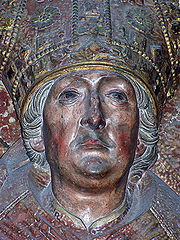
Rudolf von Scherenberg
Encyclopedia

Rudolf von Scherenberg was the son of Erhard von Scherenberg and Anna von Massbach. On April 30, 1466, he was appointed as bishop to replace Johann von Grumbach. He was confirmed as bishop on June 20, 1466. The Scherenberg Gate at the Fortress Marienberg
Fortress Marienberg
Fortress Marienberg is a prominent landmark on the Main river in Würzburg, Germany. The mighty Fortress Marienberg is the symbol of Würzburg and served as a home of the prince-bishops for nearly five centuries. It has been a fort since ancient times...
, the entrance to the main courtyard, is named after him.

Tomb
Prince-Bishop von Scherenberg is best known because of his tomb in Würzburg CathedralWürzburg Cathedral
Würzburg Cathedral is a Roman Catholic cathedral in Würzburg in Bavaria, Germany, dedicated to Saint Kilian. It is the seat of the Bishop of Würzburg...
. On his death in 1495 , his successor, Lorenz von Bibra
Lorenz von Bibra
Lorenz von Bibra, Duke in Franconia was Prince-Bishop of the Bishopric of Würzburg from 1495 to 1519. His life paralleled Maximilian I , who served as Holy Roman Emperor from 1493 to 1519, to which Lorenz did serve as an advisor....
, commissioned Tilman Riemenschneider
Tilman Riemenschneider
Tilman Riemenschneider was a German sculptor and woodcarver active in Würzburg from 1483. He was one of the most prolific and versatile sculptors of the transition period between late Gothic and Renaissance, a master in stone and limewood.- Biography :Tilman Riemenschneider was born between 1459...
to make his monument. Later, von Bibra also commissioned his own tomb from Riemenschneider a few yards away from von Scherenberg’s. Today, the two monumental effigies stand side by side, same stone and motif, but in two different styles, late Gothic
Gothic art
Gothic art was a Medieval art movement that developed in France out of Romanesque art in the mid-12th century, led by the concurrent development of Gothic architecture. It spread to all of Western Europe, but took over art more completely north of the Alps, never quite effacing more classical...
and Renaissance. One way to illustrate the change of styles is to compare the faces of the two prince-bishops: von Scherenberg’s face shows every wrinkle, while von Bibra's face is idealized. After Riemenschneider had died and was generally forgotten, these two tombs remained his best-known works. Riemenscheider was later rediscovered by the Germans and more recently by the rest of the world.

